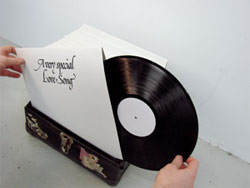A CD publication has been produced in collaboration with Clark Gallery and Gallery 101 and will be available at the gallery. This exhibition is presented in collaboration with The National Arts Centre’s Quebec Scene, April 20-May 5, 2007, a 16-day festival featuring over 100 different events, musicians, actors, dancers, visual and media artists, writers, acrobats, storytellers and master chefs.
www.quebecscene.ca
www.loreilledansloeil.org
Artists and musicians brought together through graphic scores.
Throughout the 20th century, artists and avant-garde composers turned from conventional musical notation and elaborated original visual systems. These notational practices, which can be grouped under the term graphic scores, propose new musical concepts while creating bridges between disciplines. Inspired by this process, we invited artists to create a work/score that questioned the interface between the visual and the sonic. Each score was subsequently entrusted to a musician who appropriated it and offered an interpretation. The musical pieces were recorded and are presented in conjunction with the works on exhibit via portable music players.
The dream of a “total art”, the synthesis of the disciplines has obsessed artists in every historical period. The technological advances of the last century have proven to be the partisans of this utopian right, in so far as the joining of different disciplines seems to be a given today; we have become used to the union of music and visual arts without even really noticing it. Moreover, our hyper-mediated environment offers us many declinations of this fact, from music videos to interactive artworks. It would be pointless to replay the history of the many connections between these disciplines, but nonetheless, it is key to mention that from the beginning of the twentieth century, such possibilities have stimulated avant-garde thinking. One need only think of attempts by to read Kandinski, Klee or the Dadaist and Futurist experiments to catalogue the similarities between visual signs and sounds. A few decades later, some composers were more inclined to see the relationship between sound and image as a means of escaping the rigidity of conventional notation. John Cage, Earle Brown and Morton Feldman, to name just a few, elaborated original visual systems to communicate their music. These new kinds of “notation” did not seek to exactly re-transcribe a piece of music, but rather to build conditions that would lead performers to re-evaluate their relationship to time, gesture and interaction. These practices are generally grouped together under the term graphic scores. They distinguish themselves from conventional scores by replacing part, or all, of the notation systems with geometric symbols, drawings, words or images.
Nelson Henricks, Video installation, 2007
Inspired by this artistic process that brings the visual and the sonic into an interpretive relationship with each other, we invited artists to develop visual work with the knowledge that it would subsequently be “read” like a score by a musician. Behind this premise lies our intention to explore the interface between disciplines while avoiding their assimilation into a single audiovisual work, allowing to the viewer the possibility of establishing the connections between the two mediums. The artists’ responses to the challenge of the graphic score have been various, each of them privileging certain musical parameters and providing a greater or lesser number of directives. The projects were presented to musicians in mid-stream. These meetings allowed for stimulating exchanges and often sent the artists back to their studios with a better idea of how their “compositions” were received. Even if some undertook more sustained contact with the musicians, this project was not, properly speaking, a collaborative work. The accent here is on the creation of two distinct works, but linked through an interpretive relationship. Obviously, in this laboratory, the participating musicians are more than mere executors. Far beyond any strict convention, this kind of decoding is necessarily subjective, to reference composer Earle Brown who spoke of his score December 1952, as a “composed performance” instead of a “performed composition.” The musical pieces for this project were made in this spirit.
Sébastien Cliche, Curator
-
Friday, April 20, 2007 to Saturday, May 19, 2007
Opening- Friday, April 20, 2007
